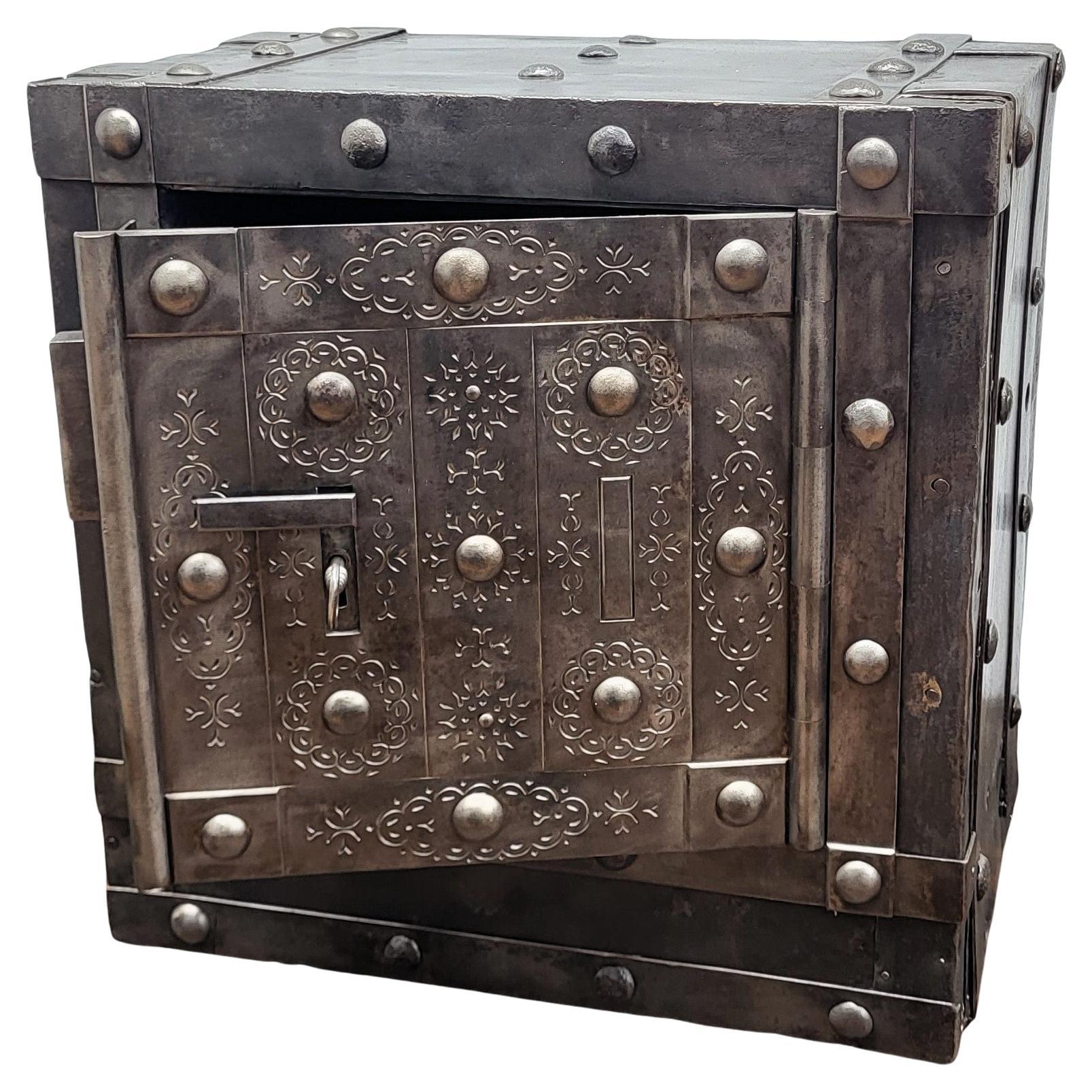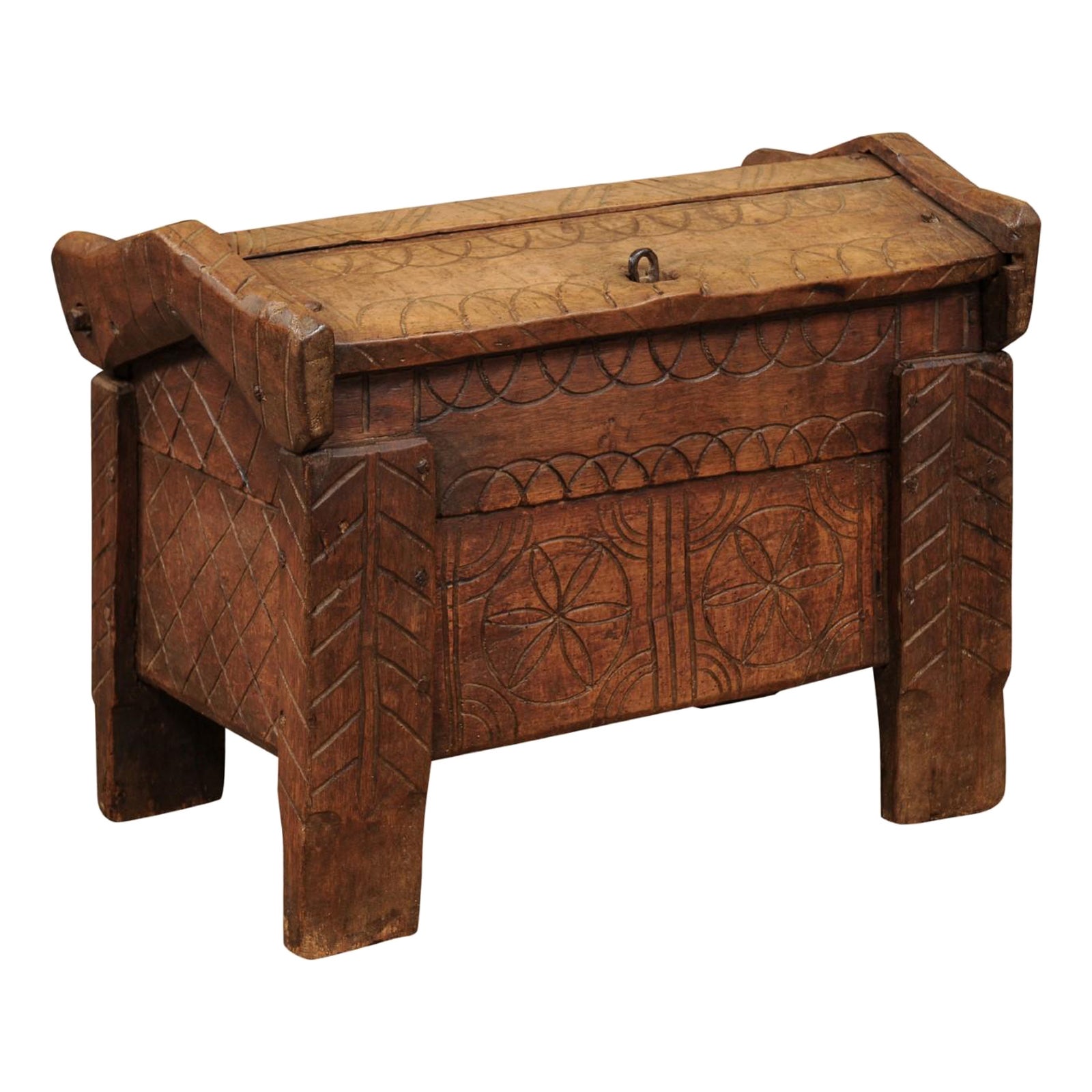Items Similar to 18th Century French Cast Iron Bound Strong Box, c.1740
Want more images or videos?
Request additional images or videos from the seller
1 of 15
18th Century French Cast Iron Bound Strong Box, c.1740
About the Item
Antique mid-18th century cast iron travel safe. Probably manufactured in France for storing money, important documents or jewellery. It would have been taken on long travels, perhaps on a long sea voyage or on the Orient express, also used as diplomats lock boxes when traveling on the continent, beautifully embossed with flowers and comes with a working lock and key.
Condition
In good condition - wear as expected.
Size
Width: 37cm
Depth: 34cm
Height: 36cm.
- Dimensions:Height: 14.18 in (36 cm)Width: 14.57 in (37 cm)Depth: 13.39 in (34 cm)
- Materials and Techniques:
- Place of Origin:
- Period:
- Date of Manufacture:circa 1740
- Condition:Wear consistent with age and use. Minor fading. In Good Condition - wear as expected.
- Seller Location:Royal Tunbridge Wells, GB
- Reference Number:
About the Seller
5.0
Platinum Seller
These expertly vetted sellers are 1stDibs' most experienced sellers and are rated highest by our customers.
Established in 2014
1stDibs seller since 2015
379 sales on 1stDibs
Typical response time: <1 hour
- ShippingRetrieving quote...Ships From: Sherring, United Kingdom
- Return PolicyA return for this item may be initiated within 14 days of delivery.
More From This SellerView All
- 20th Century Louis Vuitton Cabin Trunk, France, c.1910By Louis VuittonLocated in Royal Tunbridge Wells, KentAround the turn of the 19th and 20th century Louis Vuitton had established himself as a market leader in trunk making and needed to set his...Category
20th Century French Trunks and Luggage
MaterialsLeather, Canvas
- 18th Century Emanuel Bowen Map of County of York, c.1740By Emanuel BowenLocated in Royal Tunbridge Wells, KentAntique 18th century British rare and original Emanuel Bowen (1694-1767) map of the County of York divided into its Ridings and subdivided into wapontakes, mounted in solid wood fram...Category
Antique Early 18th Century British Maps
MaterialsPaper
- 20th Century Louis Vuitton Cabin Trunk In Natural Cow Hide, Paris, c.1910By Louis VuittonLocated in Royal Tunbridge Wells, KentA rare Louis Vuitton cabin trunk covered in leather. Dating to the early part of the 20th century, covered not in the world famous (but more common) monogram canvas but in a single piece of cow hide. These all-leather trunks were made by special order and Louis Vuitton used...Category
20th Century French Trunks and Luggage
MaterialsLeather, Canvas
- 20th Century Louis Vuitton Trunk, France c.1930By Louis VuittonLocated in Royal Tunbridge Wells, KentAn exquisite and complete Louis Vuitton trunk from the early part of the 20th century. An absolutely essential item for elite travellers of its time the trunk is adorned in the iconic LV monogrammed canvas, accented by lozine trim and brass fittings. This trunk stood as the epitome of luxury over 100 years ago, boasting an unparalleled level of sophistication and elegance, it remains a timeless masterpiece that transcends eras. The captivating allure of the Louis Vuitton trunk transforms it into more than a mere luggage accessory; it becomes a focal point for any room. With its impressive dimensions, it is perfectly suited as a striking coffee table, side table, or even as a standalone centrepiece, seamlessly integrating into any interior, whether modern or traditional. An extraordinary piece that not only pays homage to the past but also serves as a statement of unparalleled luxury in the present. A brief history about Louis Vuitton trunks: Louis Vuitton was born in 1821 to a farmer and milliner and came from a long-established working-class family in eastern France. Vuitton grew up understanding the effects of perseverance and a strong work ethic from watching his family. At the age of 16, he made the decision to walk 292 miles from his hometown to Paris to try and make a new life for himself. When he arrived the city was in the midst of industrialization with current modes of transportation evolving quickly allowing for longer journeys. With this came the need for sturdy travel pieces. Vuitton was taken as an apprentice for a successful box maker and packer named Monsieur Marechal. He learned to craft durable containers and how to pack them properly – a well-respected profession at the time.In 1854, years after he had mastered his craft and became well respected for it, Vuitton ventured out on his own to open a shop on Rue Neuve des Capucines. It was here that he began to establish himself as a luggage maker. Then, in 1858, Vuitton designed the first Louis Vuitton steamer trunk. At the time trunks had rounded tops to allow for water to run off but this did not allow for convenient stowage. Vuitton introduced a flat, yet waterproof, trunk that was easily stackable. The first of his trunks were outfitted with a grey canvas referred to as Trianon – it wouldn’t be until several decades later that the signature monogram would be introduced. With a burgeoning business, Vuitton moved his family and workplace to Asniere, where he employed twenty workers to craft his trunks. By 1900 he would have 100 employees, and in 1914 the company would more than double in size. After years of success, Vuitton began to experiment with the design of his luggage by introducing a new striped canvas pattern (1876) and later the still well-known Damier print (1888). The hand-painted patterns were developed to prevent counterfeits. Even in the late 1800s, Louis Vuitton was enough of a status symbol to warrant counterfeiting. In 1886, his son George invented and patented an ingenious locking system that made it impossible to pick the lock of their trunks. This lock is still used today. 1892 would prove to be a time of mourning for the family as Louis Vuitton passed...Category
20th Century French Other Trunks and Luggage
MaterialsBrass
- 20th Century Louis Vuitton Trunk, France c.1930By Louis VuittonLocated in Royal Tunbridge Wells, KentAn exquisite and complete Louis Vuitton trunk from the early part of the 20th century. An absolutely essential item for elite travellers of its time the trunk is adorned in the iconi...Category
20th Century French Other Trunks and Luggage
MaterialsBrass
- 20th Century Louis Vuitton Trunk, France c.1910By Louis VuittonLocated in Royal Tunbridge Wells, KentAn exquisite and complete Louis Vuitton trunk from the early part of the 20th century. An absolutely essential item for elite travellers of its time the trunk is adorned in the iconic LV monogrammed canvas, accented by lozine trim and brass fittings. This trunk stood as the epitome of luxury over 100 years ago, boasting an unparalleled level of sophistication and elegance, it remains a timeless masterpiece that transcends eras. The captivating allure of the Louis Vuitton trunk transforms it into more than a mere luggage accessory; it becomes a focal point for any room. With its impressive dimensions, it is perfectly suited as a striking coffee table, side table, or even as a standalone centrepiece, seamlessly integrating into any interior, whether modern or traditional. An extraordinary piece that not only pays homage to the past but also serves as a statement of unparalleled luxury in the present. A brief history about Louis Vuitton trunks: Louis Vuitton was born in 1821 to a farmer and milliner and came from a long-established working-class family in eastern France. Vuitton grew up understanding the effects of perseverance and a strong work ethic from watching his family. At the age of 16, he made the decision to walk 292 miles from his hometown to Paris to try and make a new life for himself. When he arrived the city was in the midst of industrialization with current modes of transportation evolving quickly allowing for longer journeys. With this came the need for sturdy travel pieces. Vuitton was taken as an apprentice for a successful box maker and packer named Monsieur Marechal. He learned to craft durable containers and how to pack them properly – a well-respected profession at the time.In 1854, years after he had mastered his craft and became well respected for it, Vuitton ventured out on his own to open a shop on Rue Neuve des Capucines. It was here that he began to establish himself as a luggage maker. Then, in 1858, Vuitton designed the first Louis Vuitton steamer trunk. At the time trunks had rounded tops to allow for water to run off but this did not allow for convenient stowage. Vuitton introduced a flat, yet waterproof, trunk that was easily stackable. The first of his trunks were outfitted with a grey canvas referred to as Trianon – it wouldn’t be until several decades later that the signature monogram would be introduced. With a burgeoning business, Vuitton moved his family and workplace to Asniere, where he employed twenty workers to craft his trunks. By 1900 he would have 100 employees, and in 1914 the company would more than double in size. After years of success, Vuitton began to experiment with the design of his luggage by introducing a new striped canvas pattern (1876) and later the still well-known Damier print (1888). The hand-painted patterns were developed to prevent counterfeits. Even in the late 1800s, Louis Vuitton was enough of a status symbol to warrant counterfeiting. In 1886, his son George invented and patented an ingenious locking system that made it impossible to pick the lock of their trunks. This lock is still used today. 1892 would prove to be a time of mourning for the family as Louis Vuitton passed...Category
20th Century French Other Trunks and Luggage
MaterialsBrass
You May Also Like
- Italian 18th Century Wrought Iron Studded Antique Safe Strong BoxLocated in Carimate, ComoThis beautiful Italian antique safe is a collector piece with typical all-around hobnails, dated circa 1820-1840, has a great metal color with patina of time and amazingly rich decor...Category
Antique Late 18th Century Italian Industrial Cabinets
MaterialsMetal, Wrought Iron
- 18th Century Iron Bound Domed Oak TrunkLocated in Dallas, TXThis handsome Baroque style oak trunk has a domed top and whimsical patinated iron mounts. The trunk was crafted in the 1700’s (possibly 1757). These types of domed oak trunks with d...Category
Antique 18th Century European Baroque Blanket Chests
MaterialsIron
- 18th Century Welsh Strong Box with Carved DetailLocated in Atlanta, GA18th Century Welsh strong box with carved detail.Category
Antique 18th Century Welsh Decorative Boxes
MaterialsWood
- 18th Century Spanish Iron-Clad Strong Box in Working Condition with Original KeyLocated in Atlanta, GAA Spanish strong box from the 18th century. This antique safe from is constructed or iron clad wood, and is handsomely adorn in domed iron nailhead trim throughout it's top, front, a...Category
Antique 18th Century Spanish Trunks and Luggage
MaterialsIron
- Colossal Terrestrian Globe Hand Painted, French, First Half of the 18th CenturyLocated in Saint-Ouen, FRColossal Terrestrian globe hand painted, French, first half of the 18th century. Mounted in a 19th century pedestal wood.Category
Antique 1730s French Globes
MaterialsBeech
- 17th Century forged Iron Safe strong boxLocated in Madrid, ES17th Century Iron Safe Old safe for collecting money or valuables from the 17th century in hand-forged iron and including its original key. The lock works pe...Category
Antique 17th Century Nautical Objects
MaterialsWrought Iron
Recently Viewed
View AllMore Ways To Browse
Homer Jewelry
Travel Iron
Important Documented
18th Century Lock Antique
18th Century Jewelry
18th Century French Jewellery
Iron Lock Key
Safe Lock
Antique French Trunks
Iron Antique Keys
Antique Iron Jewelry
Iron Antique Safe
Orient Express
Antique Travel Iron
Antique Safe Key
Strong Box Key
Luggage And Travel Boxes
Cast Iron Box





